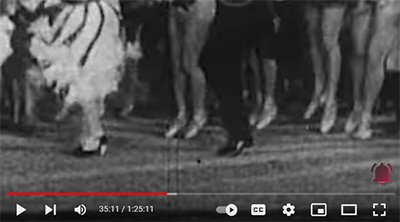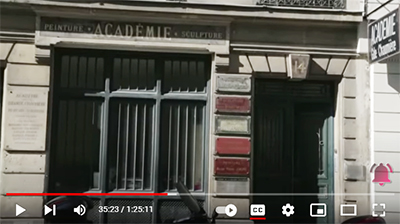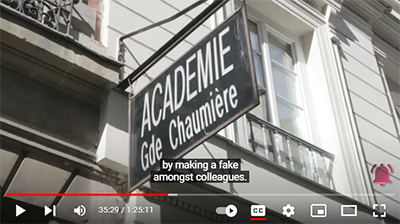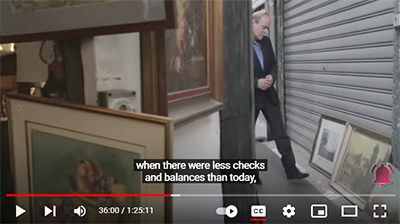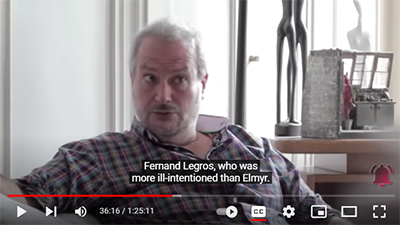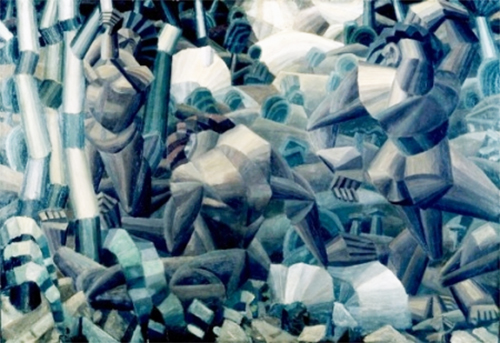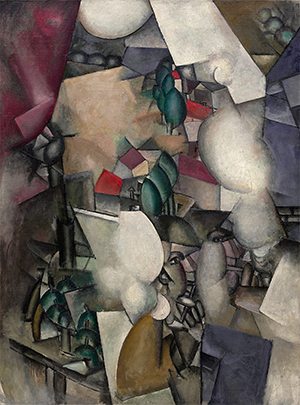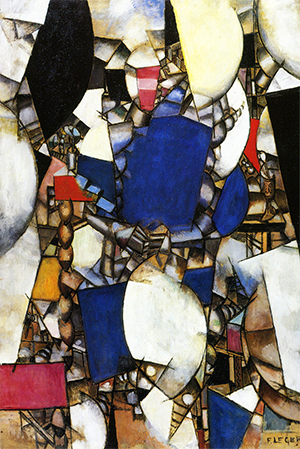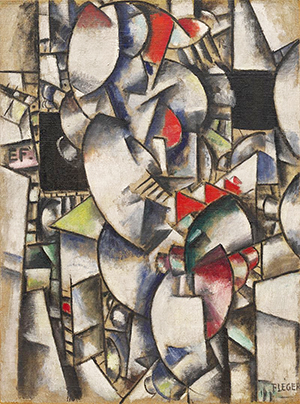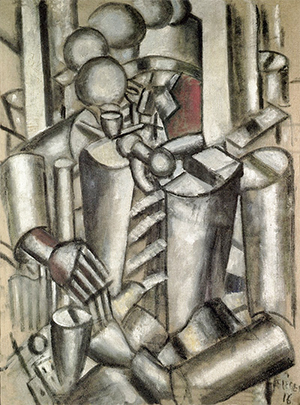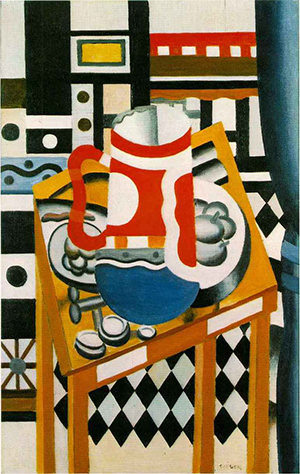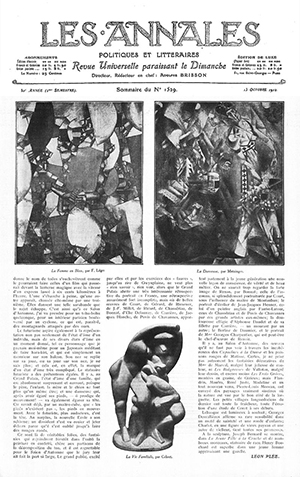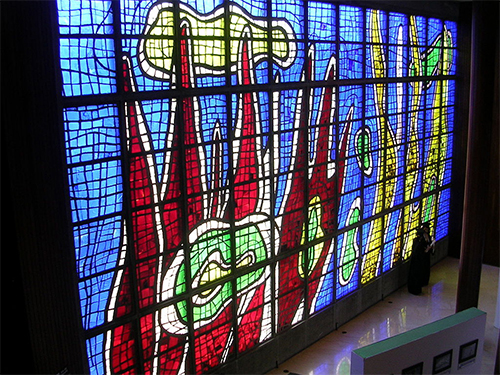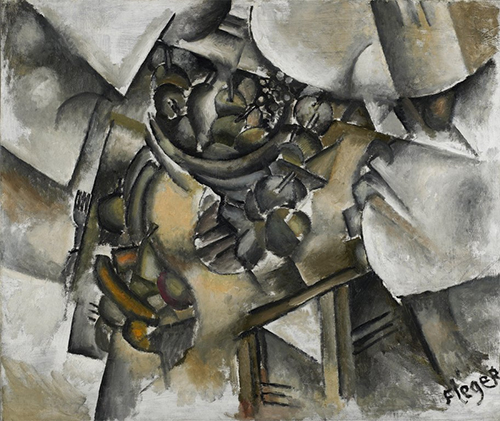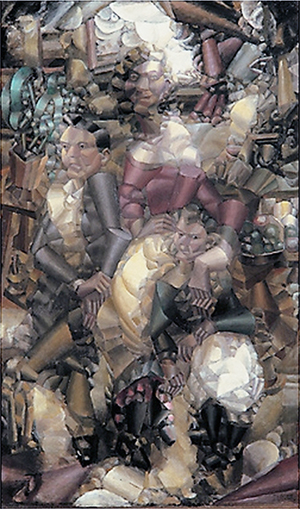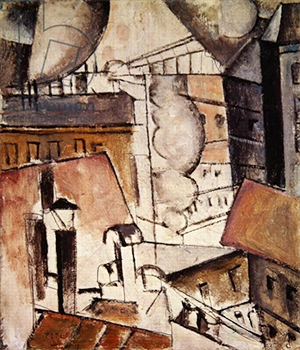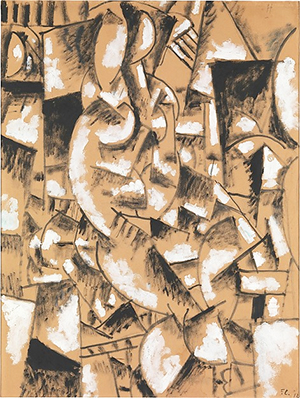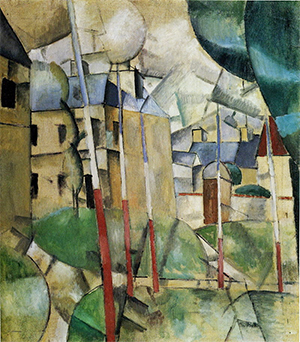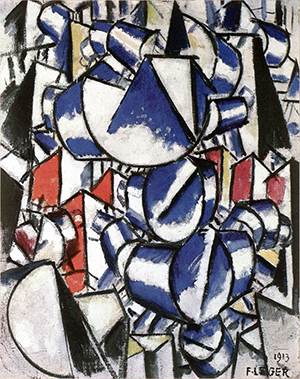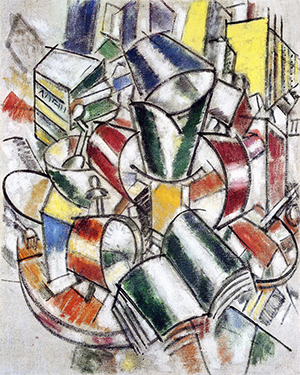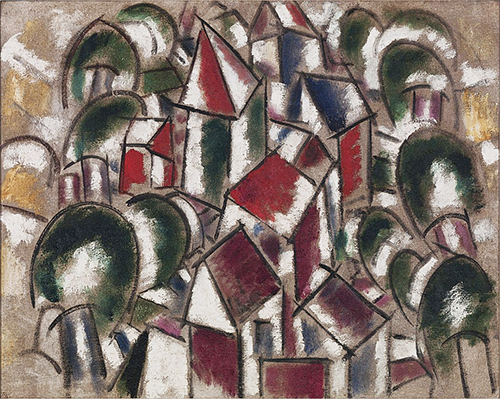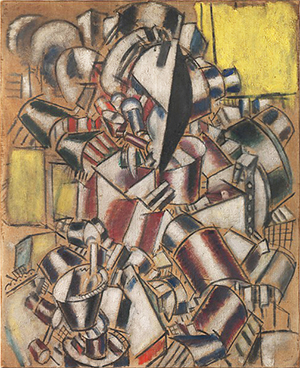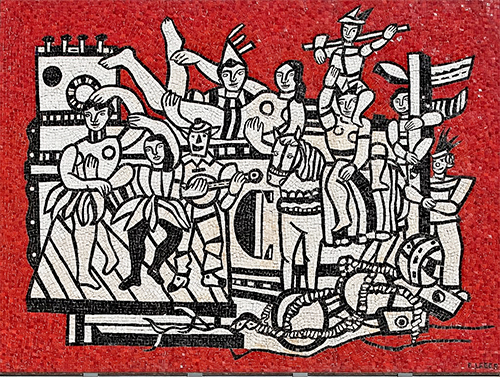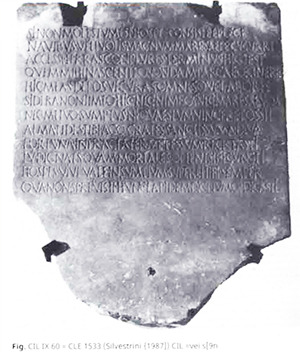by Wikipedia
Accessed: 10/13/22
[Narrator] For eight years, John Myatt and John Drewe colluded to achieve what has been dubbed "The Greatest Art Fraud of the 20th Century." The duo had no idea that suspicions were being roused within the art world. But forger John Myatt was becoming less and less comfortable with his partner-in-crime, John Drewe, and their joint deception.
[John Myatt, Forger] I was certain that it was going to end in, you know, tears. It was just a matter of, you know, when.
[Jacqui Hames, Metropolitan Police Detective] As the con went on, the web of lies was obviously very complicated. But John Drewe had to sort of really fantasize, and put himself in the reality of it. And to him it was real. These paintings were genuine paintings.
[John Myatt, Forger] I remember, on one occasion, in an Italian restaurant, he was going on about a painting. And I said, "Come on, John. Just shut up for a minute. I painted these paintings. They're fakes." "Aaaahhh". And off he goes. He said, "No, no, no, no. You're wrong. These are not fake. I believe these are original paintings." And that was what he did! I guess that's the secret of being a success in that, you know, conning department. It's part of you has to sell to yourself, you know, across the sort of left side to the right side of the brain, or something. You have to persuade yourself that these are authentic paintings. And then you can be credible.
[Joel Levy, Con Expert] The way that Drewe talked about, um, how "these weren't fakes -- they were real artworks," is maybe indicative that he was an example of what psychologists call, "fantasy prone personality." Now "fantasy prone personality" is someone who has trouble differentiating between fact and fantasy. And that he literally was not very good at telling the difference between his lies and the truth, and therefore, came to believe that his lies were the truth. Which of course would have made him a much more effective con man....
[Narrator] The game was up. With Myatt's honesty, the case strengthened further. After passing off over 200 fake paintings, and repeated corruption of the archives at the Tate, and the V&A [Victoria and Albert] in London, England, the police finally arrested John Drewe.
[Jonathan Searle, Fraud Squad, New Scotland Yard] We found him to be very charming, affable, intelligent, highly intelligent man, with a very high IQ, a very, very good memory, and we found difficulty in believing virtually anything he said. We found a number of forged provenances. And he denied the whole lot. Well, he said they were genuine. And he went through court saying the whole lot were genuine. And in fact, he said the whole lot, were not only were they genuine despite the forensic evidence, despite the evidence of all the witnesses, not only that, he said it was an MI5 plot, which is real boy's own stuff. Absolute nonsense.
[Narrator] With Drewe and Myatt charged, the courtroom beckoned. But Drewe didn't seem ready for his day in the dock.
[John Myatt] We went through the whole palaver, going to Magistrates' court. And John would come into Magistrates' court. And as soon as he got there, he would pretend to have a heart attack. And then they'd have to adjourn the case. And you know, six months later we'd be back in Magistrates' court, and he'd have another heart attack in the foyer. You know, "haaah haaah haaah haaah." And off he'd go. So he took three Magistrates' court hearings before the Magistrate said, "Look, if he has to come in in a stretcher, get him in!"
[Narrator] So after several false starts, Myatt and Drewe headed to the Crown Court.
[John Myatt] And eventually got to Southwark Crown Court. And I knew what I was going to do. I was going to plead guilty. And that was that. And it was the best thing to do. I was guilty. So I couldn't see much point in trying to, you know, get my way out of it.
[Narrator] Despite Myatt's guilty plea, Drewe pleaded, "not guilty." And two days into the trial, John Drewe sacked his legal representation, and opted to defend himself in court, with no legal counsel.
[Joel Levy, Con Expert] I think the fact that Drewe elected to represent himself does tell us a lot about his psychology. Because it seems to me like a classic instance of the sociopathic con man who thinks that he is cleverer than everybody else. Who thinks that he's better than everybody else. Who thinks he doesn't need to bother with all the sort of apparatus of the state. He doesn't need a solicitor, or a court-appointed lawyer, or anything like that. That he can do a better job than any of them. It's a classic example of how deluded he was, I suppose.
[Jonathan Searle, Fraud Squad, New Scotland Yard] He defended himself very ably. And as I say, he had a, he has a very, very good mind. A very retentive memory. But in court he gave his qualifications as being a professor. Well, we tried very, very hard to find out exactly where he had got his qualifications from. The last thing we were told, it was in Germany somewhere. And so I don't know how much of it is true, how much of it is not true.
[Jacqui Hames, Metropolitan Police Detective] The fact that he represented himself in court shows, again, a complete arrogance and disdain for authority. He didn't feel that anybody else was capable of representing him.
[Narrator] In a brazen show of arrogance, John Drewe cross-examined representatives of the art world that he himself had attempted to con.
[Mary Lisa Palmer, Director, Giacometti Association] I was asked to be a witness in court. And as Mr. Drewe esteemed that he didn't need a lawyer, he did the questioning. And it was quite funny. At one point, he was asking me a certain question about a certain work, and he was mixing up his works. And I had to correct him on that.
[Joel Levy, Con Expert] Part of the reason that he was able to pull off the scam, or even attempt it in the first place, is because he thought he was cleverer than everybody else. But of course, that in itself, was the seed of his downfall, if you like. Because he's always cleverer than everyone else. He stopped being careful enough, and allowed himself to get tripped up.
[Peter Nahum, Art Dealer] I was a witness at his trial, which was rather surreal. Since Drewe didn't have a lawyer, he was defending himself, and being cross-questioned by the man who I had put there, or was one of the people who was put there. It was quite a strange experience. He did ask me some questions about -- I think he was trying to show that I wasn't a very good expert, and I didn't know what I was doing. But when I got down from the witness box I heard the Crown Prosecution lawyer say, "Oh well, Drewe didn't get anywhere with that witness then."...
[Narrator] Forger-turned-prosecution-witness Myatt had done himself a favor, and received 12 months for his role in the scam. Mastermind John Drewe, however, was sentenced to six years in prison....
[Joel Levy, Con Expert] It seems to me that John Drewe has most of the traits of the classic con man. He seems like an absolutely archetypal classic con man. Because he's obviously quite a, sort of, smooth operator. He's obviously very convincing. He's obviously quite happy to move in high society, for many years, without fear of being detected. He kept pulling this scam, which is an audacious scam, without any fear of being detected. And he's obviously adaptable and resourceful. You know, he's clever when he needs to be. He can even do some hard work when he needs to do it. So this guy obviously is, really, a very good con man.
[Peter Nahum, Art Dealer] John Drewe is a very intelligent man. As far as we can see, he's dangerous because he lives in a dreamland. And therefore, it's very hard to discipline people like that. People who know they've done wrong might, or might not, do it in the future. Somebody who lives in la la land, we have a problem with. But he's a very intelligent man.
-- Inside Criminal Minds ... Con Men, [The Cunning Genius Who Fooled The Art World: John Myatt], Narration by Anthony Wilson
A far more promising approach to the problem, indeed a short cut, seemed to be heralded in a letter to Jones from Lieutenant Francis Wilford, a surveyor and an enthusiastic student of all things oriental, who was based at Benares. Jones had been sent copies of inscriptions found at Ellora and written in Ashoka Brahmi, the still undeciphered pin-men. He had probably sent them to Wilford because Benares, the holy city of the Hindus, was the most likely place to find a Brahmin who might be able to read them. In 1793 Wilford announced that he had found just such a man:I have the honour to return to you the facsimile of several inscriptions with an explanation of them. I despaired at first of ever being able to decipher them... However, after many fruitless attempts on our part, we were so fortunate as to find at last an ancient sage, who gave us the key, and produced a book in Sanskrit, containing a great many ancient alphabets formerly in use in different parts of India. This was really a fortunate discovery, which hereafter may be of great service to us.
According to the ancient sage, most of Wilford's inscriptions related to the wanderings of the five heroic Pandava brothers from the Mahabharata. At the unspecified time in question they were under an obligation not to converse with the rest of mankind; so their friends devised a method of communicating with them by "writing short and obscure sentences on rocks and stones in the wilderness and in characters previously agreed upon betwixt them." The sage happened to have the key to these characters in his code book; obligingly he transcribed them into Devanagari Sanskrit and then translated them.
To be fair to Wilford, he was a bit suspicious about this ingenious explanation of how the inscriptions got there. But he had no doubts that the deciphering and translation were genuine. "Our having been able to decipher them is a great point in my opinion, as it may hereafter lead to further discoveries, that may ultimately crown our labours with success." Above all, he had now located the code book, "a most fortunate circumstance."Fake provenance is used to help authenticate a fake work of art. -- Provenances: Real, Fake, and Questionable, International Journal of Cultural Property, by Cambridge University Press
Poor Wilford was the laughing stock of the Benares Brahmins for a whole decade. They had already fobbed him off with Sanskrit texts, later proved spurious, on the source of the Nile and the origin of Mecca. After the code book there was a geographical treatise on The Sacred Isles of the West, which included early Hindu reference to the British Isles. The Brahmins, to whom Sanskrit had so long remained a sacred prerogative, were getting their own back. One wonders how much Wilford paid his "ancient sage."
Jones was already a little suspicious of Wilford's sources, but on the code book, which was as much a fabrication as the translations supposedly based on it, he reserved judgment until he might see it. He never did. In fact it was never heard of again. But in spite of these disappointments Jones continued to believe that in time this oldest script would be deciphered. He had been sent a copy of the writings on the Delhi pillar and told a correspondent that they "drive me to despair; you are right, I doubt not, in thinking them foreign; I believe them to be Ethiopian and to have been imported a thousand years before Christ." It was not one of his more inspired guesses and at the time of his death the mystery of the inscriptions and of the monoliths was as dark as ever.
-- India Discovered, by John Keay
Fantasy prone personality (FPP) is a disposition or personality trait in which a person experiences a lifelong, extensive, and deep involvement in fantasy.[1] This disposition is an attempt, at least in part, to better describe "overactive imagination" or "living in a dream world".[2] An individual with this trait (termed a fantasizer) may have difficulty differentiating between fantasy and reality and may experience hallucinations, as well as self-suggested psychosomatic symptoms. Closely related psychological constructs include daydreaming, absorption and eidetic memory.
History
American psychologists Sheryl C. Wilson and Theodore X. Barber first identified FPP in 1981, said to apply to about 4% of the population.[3] Besides identifying this trait, Wilson and Barber reported a number of childhood antecedents that likely laid the foundation for fantasy proneness in later life, such as, "a parent, grandparent, teacher, or friend who encouraged the reading of fairy tales, reinforced the child's ... fantasies, and treated the child's dolls and stuffed animals in ways that encouraged the child to believe that they were alive." They suggested that this trait was almost synonymous with those who responded dramatically to hypnotic induction, that is, "high hypnotizables".[1]
The first systematic studies were conducted in the 1980s by psychologists Judith Rhue and Steven Jay Lynn.[1] Later research in the 1990s by Deirdre Barrett at Harvard confirmed most of these characteristics of fantasy prone people, but she also identified another set of highly hypnotizable subjects who had had traumatic childhoods and who identified fantasy time mainly by "spacing out".[4]
Characteristic features
Fantasy prone persons are reported to spend up to half (or more) of their time awake fantasizing or daydreaming. People with Type 1 FPP will often confuse or mix their fantasies with their real memories. They also report out-of-body experiences, and other similar experiences that are interpreted by the some fantasizers as psychic (parapsychological) or mystical.[3] However, those with Type 2 have perfect ability to distinguish between reality and fantasy, much like the people with schizoid personality disorder.
A paracosm is an extremely detailed and structured fantasy world often created by extreme or compulsive fantasizers.[5]
Wilson and Barber listed numerous characteristics in their pioneer study, which have been clarified and amplified in later studies.[6][7] These characteristics include some or many of the following experiences:
• excellent hypnotic subject (most but not all fantasizers)
• having imaginary friends in childhood
• fantasizing often as child
• having an actual fantasy identity
• experiencing imagined sensations as real
• having vivid sensory perceptions
• receiving sexual satisfaction without physical stimulation
Fantasy proneness is measured by the "inventory of childhood memories and imaginings" (ICMI)[8] and the "creative experiences questionnaire (CEQ).[9]
Developmental pathways
Fantasizers have had a large exposure to fantasy during early childhood.[1][6] This over-exposure to childhood fantasy has at least three important causes:
• Parents or caregivers who indulged in their child's imaginative mental or play environment during childhood.
People with fantasy prone personalities are more likely to have had parents, or close family members that joined the child in believing toys are living creatures. They may also have encouraged the child who believed they had imaginary companions, read fairytales all through childhood and re-enacted the things they had read. People who, at a young age, were involved in creative fantasy activities like piano, ballet, and drawing are more likely to obtain a fantasy prone personality.[citation needed] Acting is also a way for children to identify as different people and characters which can make the child prone to fantasy-like dreams as they grow up.[citation needed] This can cause the person to grow up thinking they have experienced certain things and they can visualize a certain occurrence from the training they obtained while being involved in plays.[citation needed]
People have reported that they believed their dolls and stuffed animals were living creatures and that their parents encouraged them to indulge in their fantasies and daydreams.[9] For example, one subject in Barrett's study said her parents' standard response to her requests for expensive toys was, "You could take this (household object) and with a little imagination, it would look just like (an expensive gift)."[10]
• Exposure to abuse, physical or sexual, such that fantasizing provides a coping or escape mechanism.
• Exposure to severe loneliness and isolation, such that fantasizing provides a coping or escape mechanism from the boredom.
Regarding psychoanalytic interpretations, Sigmund Freud stated that "unsatisfied wishes are the driving power behind fantasies, every separate fantasy contains the fulfillment of a wish, and improves an unsatisfactory reality." This shows childhood abuse and loneliness can result in people creating a fantasy world of happiness in order to fill the void.[1]
Related constructs
Openness to experience is one of the five domains that are used to describe human personality in the Five Factor Model.[11] Openness involves six facets, or dimensions, including active imagination (fantasy), aesthetic sensitivity, attentiveness to inner feelings, preference for variety, and intellectual curiosity. Thus, fantasy prone personality correlates with the fantasy facet of the broader personality trait Openness to Experience.
Absorption is a disposition or personality trait in which a person becomes absorbed in his or her mental imagery, particularly fantasy.[12] The original research on absorption was by American psychologist Auke Tellegen.[13] Roche reports that fantasy proneness and absorption are highly correlated.[12] Fantasizers become absorbed within their vivid and realistic mental imagery.
Dissociation is a psychological process involving alterations in personal identity or sense of self. These alterations can include: a sense that one's self or the world is unreal (derealization and depersonalization); a loss of memory (amnesia); forgetting one's identity or assuming a new self (fugue); and fragmentation of identity or self into separate streams of consciousness (dissociative identity disorder, formerly termed multiple personality disorder). Dissociation is measured most often by the Dissociative Experiences Scale. Several studies have reported that dissociation and fantasy proneness are highly correlated. This suggests the possibility that the dissociated selves are merely fantasies, for example, being a coping response to trauma. However, a lengthy review of the evidence concludes that there is strong empirical support for the hypothesis that dissociation is caused primarily and directly by exposure to trauma, and that fantasy is of secondary importance.[14]
Health implications
False pregnancy (pseudocyesis) - A high number of female fantasizers – 60% of the women asked in the Wilson-Barber study – reported that they have had a false pregnancy (pseudocyesis) at least once. They believed that they were pregnant, and they had many of the symptoms. In addition to amenorrhea (stoppage of menstruation), they typically experienced at least four of the following: breast changes, abdominal enlargement, morning sickness, cravings, and "fetal" movements. Two of the subjects went for abortions, following which they were told that no fetus had been found. All of the other false pregnancies terminated quickly when negative results were received from pregnancy tests.[3]
Maladaptive daydreaming is a proposed psychological disorder, a fantasy activity that replaces human interaction and interferes with work, relationships and general activities. Those with this pathology daydream or fantasize excessively, assuming roles and characters in scenarios created to their liking. People with excessive daydreaming are aware that the scenarios and characters of their fantasies are not real and have the ability to determine what is real, elements that differentiate them from those with schizophrenia.[15][16]
See also
• Hyperphantasia
• Suggestibility
• "The Secret Life of Walter Mitty"
References
1. Lynn, Steven J.; Rhue, Judith W. (1988). "Fantasy proneness: Hypnosis, developmental antecedents, and psychopathology". American Psychologist. 43 (1): 35–44. doi:10.1037/0003-066x.43.1.35. PMID 3279876.
2. Glausiusz, Josie (2011). "Living in a dream world". Scientific American Mind. 20 (1): 24–31. doi:10.1038/scientificamericanmind0311-24.
3. Wilson, S. C. & Barber, T. X. (1983). "The fantasy-prone personality: Implications for understanding imagery, hypnosis, and parapsychological phenomena." In, A. A. Sheikh (editor), Imagery: Current theory, research and application (pp. 340–390). New York: Wiley. ISBN 0471 092258. Republished (edited): Psi Research 1(3), 94 – 116. http://psycnet.apa.org/psycinfo/1983-22322-001.
4. Barrett, D. L. The hypnotic dream: Its content in comparison to nocturnal dreams and waking fantasy. Journal of Abnormal Psychology, 1979, Vol. 88, p. 584 591; Barrett, D. L. Fantasizers and dissociaters: Two types of high hypnotizables, two imagery styles. In R. G. Kunzendorf, N. Spanos, & B. Wallace (Eds.) Hypnosis and Imagination, NY: Baywood, 1996 (ISBN 0895031396); Barrett, D. L. Dissociaters, fantasizers, and their relation to hypnotizability. In Barrett, D. L. (Ed.) Hypnosis and Hypnotherapy (2 vols): Vol. 1: History, theory and general research, Vol. 2: Psychotherapy research and applications, NY: Praeger/Greenwood, 2010.
5. Mackeith, S. & Silvey, R. (1988). The paracosm: a special form of fantasy. In, Morrison, D.C. (Ed.), Organizing early experience: Imagination and cognition in childhood (pages 173 – 197). New York: Baywood. ISBN 0895030519.
6. Rhue, Judith W.; Jay Lynn, Steven (1987). "Fantasy proneness: Developmental antecedents". Journal of Personality. 55: 121–137. doi:10.1111/j.1467-6494.1987.tb00431.x.
7. Novella, Steven (2007-04-03). "The Fantasy prone personality". NeuroLogica Blog. Self-published. Retrieved 2011-11-13.
8. Myers, S. A. (1983). "The Wilson-Barber Inventory of Childhood Memories and Imaginings: Children's form [etc]". Journal of Mental Imagery. 7: 83–94.
9. Merckelbach, H.; et al. (2001). "The Creative Experiences Questionnaire (CEQ): a brief self-report measure of fantasy proneness". Personality and Individual Differences. 31 (6): 987–995. doi:10.1016/s0191-8869(00)00201-4. Archived from the original on 2021-01-27. Retrieved 2019-12-05.
10. Barrett, D. L. (2010). Dissociaters, fantasizers, and their relation to hypnotizability. Chapter 2, in Barrett, D. L. (Ed.), Hypnosis and Hypnotherapy (2 vols) New York: Praeger/Greenwood, p. 62 – 63.
11. McCrae, R. R. (1994). "Openness to experience: Expanding the boundaries of Factor-V". European Journal of Personality. 8 (4): 251–272. doi:10.1002/per.2410080404. S2CID 144576220. Archived from the original on 2021-01-27. Retrieved 2021-01-27.
12. Roche, Suzanne M.; McConkey, Kevin M. (1990). "Absorption: Nature, assessment, and correlates". Journal of Personality and Social Psychology. 59 (1): 91–101. doi:10.1037/0022-3514.59.1.91. ISSN 0022-3514.
13. Tellegen, Auke; Atkinson, Gilbert (1974). "Openness to absorbing and self-altering experiences ("absorption"), a trait related to hypnotic susceptibility". Journal of Abnormal Psychology. 83 (3): 268–277. doi:10.1037/h0036681. ISSN 0021-843X. PMID 4844914.
14. Dalenberg, Constance J.; Brand, Bethany L.; Gleaves, David H.; et al. (2012). "Evaluation of the evidence for the trauma and fantasy models of dissociation" (PDF). Psychological Bulletin. 138 (3): 550–588. doi:10.1037/a0027447. ISSN 1939-1455. PMID 22409505. Archived from the original on 2021-01-27. Retrieved 2019-02-13.
15. Somer, Eli (2002). "Maladaptive daydreaming: A qualitative inquiry" (PDF). Journal of Contemporary Psychotherapy. 32 (2/3): 197–211. doi:10.1023/A:1020597026919. S2CID 27013772. Archived (PDF) from the original on 2018-11-27. Retrieved 2018-11-03.
16. Bigelsen, Jayne; Schupak, Cynthia (2011). "Compulsive fantasy: Proposed evidence of an under-reported syndrome through a systematic study of 90 self-identified non-normative fantasizers". Consciousness and Cognition. 20 (4): 1634–1648. doi:10.1016/j.concog.2011.08.013. ISSN 1053-8100. PMID 21959201. S2CID 206954778.









